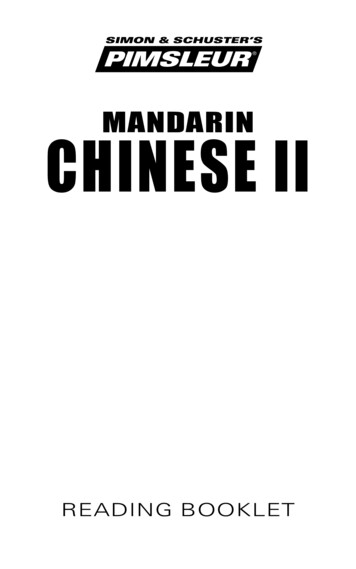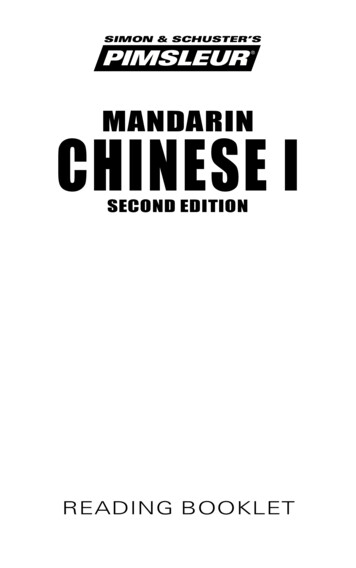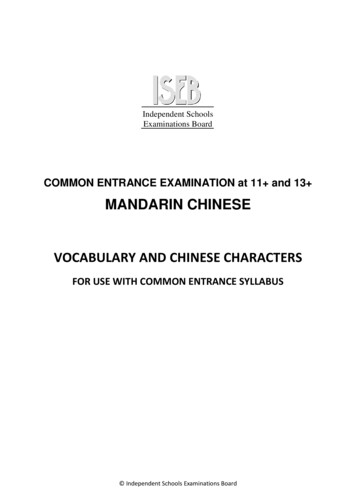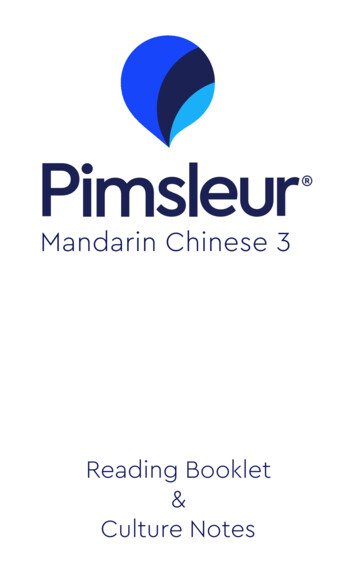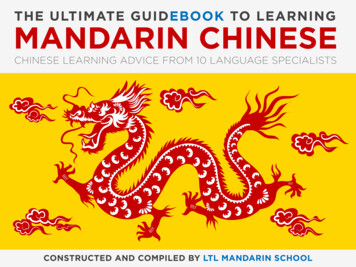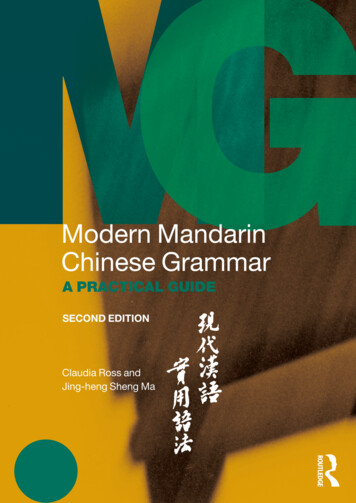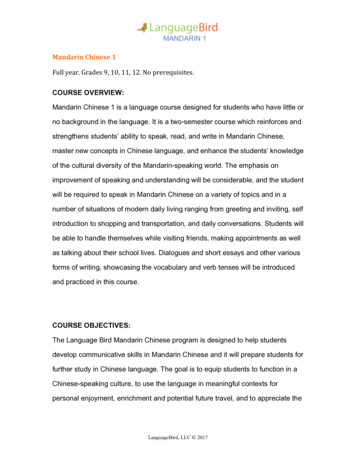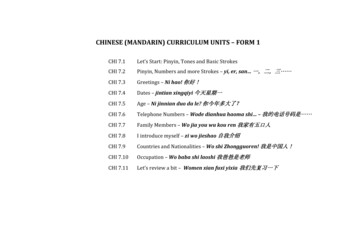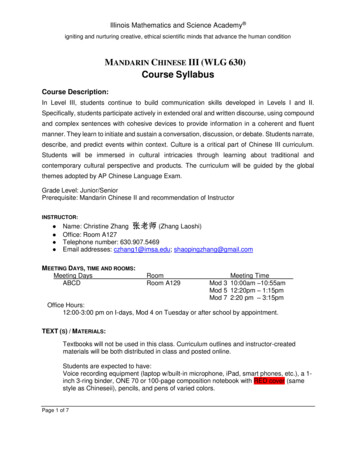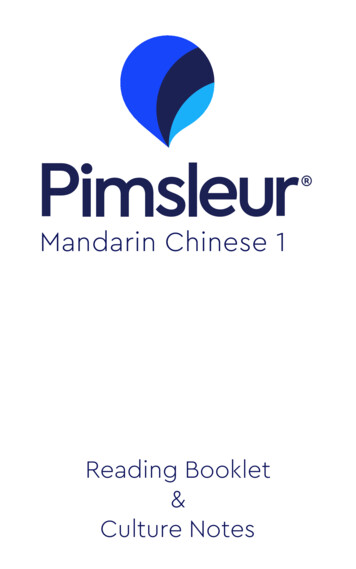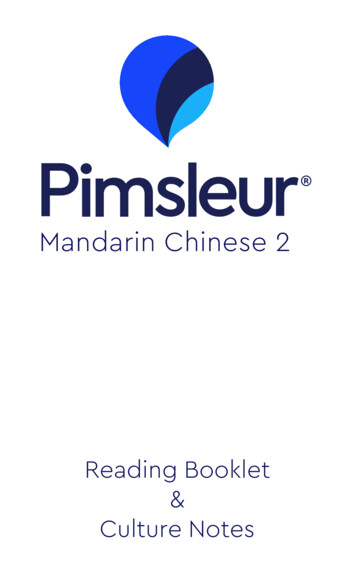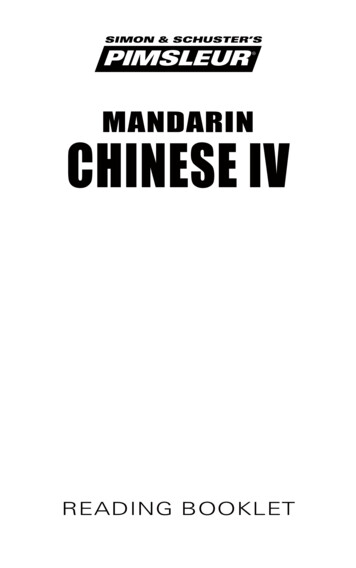
Transcription
SIMON & SCHUSTER’SPIMSLEUR MANDARINchinese IVreading booklet
Travelers should always check with theirnation's State Department for currentadvisories on local conditions beforetraveling abroad.Graphic Design: Maia Kennedy and ‰ Recorded Program 2013 Simon & Schuster, Inc. Reading Booklet 2013 Simon & Schuster, Inc.Pimsleur is an imprint of Simon & Schuster Audio,a division of Simon & Schuster, Inc. Mfg. in USA.All rights reserved.
acknowledgmentsUnit 1Mandarin IVVoicesEnglish-Speaking Instructor . . . . . . . . . . . Ray BrownMandarin-Speaking Instructor . . . . . . . Zongyao YangFemale Mandarin Speaker. . . . . . . . . . . . Xinxing YangMale Mandarin Speaker . . . . . . . . . . Pengcheng WangCourse WritersYaohua Shi Shannon RossiChristopher J. GaintyReviewerZhijie JiaEditor & Executive ProducerBeverly D. HeinleProducer & DirectorSarah H. McInnisRecording EngineersPeter S. TurpinSimon & Schuster Studios, Concord, MAiii
table of contentsUnit 1NotesUnit 1: Major Airport Hubs in China. 1Unit 2: The Huangpu River. 2The Yu Garden. 2Unit 3: Bridges Over the Huangpu River. 4Unit 4: Skyscrapers in Pudong. 5Unit 5: Jiading. 6Nanxiang. 6Unit 6: Guyiyuan. 7Anting. 8Unit 7: Anting New Town. 8Unit 8: Shanghai Automobile Museum. 9Shanghai International Circuit. 9Unit 9: Cars, Bicycles, and the Environment. 9Unit 10: Exercise and Street Dancing. 10Unit 11: “Little Emperors” and the“Silver Haired Tribe”. 11Unit 12: “Is Professor Li’s son married?”. 12Unit 13: airen. 13Unit 14: Pet Ownership. 13Unit 15: Flower and Bird Markets. 14Auspicious Animals and Flowers. 14Unit 16: Popular Associations with ChineseZodiac Signs. 15v
table of contentsUnit 1NotesUnit 17: Organic Food. 16Vegetarianism. 16Unit 18: Sichuan Cuisine. 17Unit 19: Chengdu. 18Unit 20: Halal Restaurants. 19Flat Bread in Mutton Broth and Xi’anStreet Food. 19Unit 21: Xi’an. 20Unit 22: Northern and Southern China. 21Unit 23: The 798 Art District. 22Unit 24: Massage Parlors and Bath Palaces. 22Unit 25: Cupping and Acupuncture. 23Unit 26: Kunming. 24Yunnan and Biodiversity. 25Unit 27: Pu’er Tea. 25Yiwu. 26Unit 28: Solar Energy and Solar Panels. 26The Canton Fair. 27Unit 29: Shenzhen. 27Unit 30: yum cha. 28Hong Kong. 29vi
Mandarin IVUnit 1Major Airport Hubs in ChinaThe three busiest Chinese airports are in Shanghai,Beijing, and Guangzhou. Shanghai has two airports.Pudong International Airport, the city’s gateway to theworld, lies 19 miles east of the city center by the EastChina Sea. Its cargo terminal is the country’s busiest.Construction of the first runway and terminal beganin 1997 and took only two years to complete. Theairport was soon expanded to include three runwaysand two terminals. Terminal 2 serves internationalairlines. Closer to downtown, the older HongqiaoAirport connects Shanghai to the rest of the country andmajor East Asian metropolises: Tokyo, Seoul, Taipei,and Hong Kong. A mega expansion in 2010 created asecond terminal as well as concourses linking the city’ssubways, long distance buses, and high-speed railways.Beijing Capital Airport is China’s largest airport andthe world’s second busiest after Atlanta’s HartsfieldJackson International. Terminal 3, which covers anarea of more than ten million square feet, is the world’ssecond largest passenger terminal. It includes a main andtwo satellite concourses. Plans to build a second airportwere approved by the central government in 2012.Guangzhou, formerly known as Canton, is the capitalof Guangdong province, which is one of the country’smost important economic engines. The Pearl River deltaregion is home to China’s largest manufacturing base.Guangzhou hosts an annual trade fair, which attractsbuyers from around the world. A large percentage of
Mandarin IVUnit 1 (continued)the overseas Chinese population in Southeast Asiaand elsewhere originates from Guangdong. It is notsurprising that Guangzhou Baiyun International is thethird major airline hub in China.Unit 2The Huangpu RiverThe Huangpu, a tributary of the Yangtze River,meanders through Shanghai. The most scenic part of theriver is called the Bund, an Anglo-Indian word meaning“embankment.” It bears a remarkable resemblance tothe waterfront of Liverpool, England. The similarity isby no means accidental: the architectural legacy of theBund is a reminder of the century-long British influencein Shanghai from the 1840s to the 1940s. The skylineis dominated by imposing former bank buildings in avariety of eclectic western styles. Many have beenconverted into luxury boutiques, upscale restaurants,and art galleries. Tourists throng the long esplanadeto take in the views and snap pictures of the bargesand buildings along the banks of the river. East of theHuangpu is the Pudong New Area. As its name suggests,until the 1990s that part of the city was still largely ruralin character.The Yu GardenThe Yu Garden and its surrounding area is a majortourist attraction in Shanghai. It is located in Shanghai’s2
Mandarin IVUnit 2 (continued)old city not far from the Huangpu River. First constructedin the 16th century, the historic garden featuresmultiple pavilions, ponds, and artificial rockeries.The original owner intended the garden as a retreatfor his parents, naming it the “Garden of Tranquility.”However, construction took so long that in reality thegarden became a playground for the profligate retiredgovernment official. After he died, the garden quicklyfell into decline. Over the centuries, ownership changedhands and the garden was rebuilt numerous times.Today the walled garden fronts a small man-made lakewith a picturesque pavilion in the middle and a zigzagwalkway called the Nine-Bend Bridge. The hexagonalpavilion was built in the 18th century as a gatheringplace for cloth merchants. Today it’s a teahouse. Thewalkway, originally made of wood, was destroyed bya fire in 1922. Two years later it was reconstructed inconcrete. From the bridge skyscrapers on the other sideof the Huangpu River are clearly visible over treetops inthe garden forming a dramatic backdrop. The five-acregarden is embedded in a cobweb of narrow alleywayslined with restaurants and specialty shops selling traditional crafts such as chopsticks, combs, folding fans,and paper cuts. Nearby there are several Taoist templesincluding one devoted to the City God.3
Mandarin IVUnit 3Bridges over the Huangpu RiverUntil 1991, the only way to cross the Huangpu Riverin downtown Shanghai was by ferry. However, followingthe central government’s decision to develop the areaeast of the river, within about ten years, four bridgeswere constructed over the river within the city limits.The first to complete was the Nanpu Bridge. It’s a cablestayed bridge with a main span of 1,388 feet. Becauseof its cramped location, the two-mile long ramp west ofthe river is in the shape of a double helix climbing to aheight of 151 feet. Two years later the Yangpu Bridgeopened to traffic. It is a double-tower and double-cablestayed bridge. Its 1,975-foot span makes it one of thelargest cable-stayed bridges in the world. It connectsthe Inner Ring Expressway in the industrial YangpuDistrict in Puxi to the Pudong New Area. The bridge,originally unpainted, received a festive coat of red paintfor the new millennium. The third bridge, the Xupu, isvery similar in design. It got its name from its locationin Xupu District and is connected to the Outer RingExpressway. It opened in 1997. The fourth bridge is theLupu Bridge in downtown Shanghai. Like the SidneyHarbor Bridge in Australia, the Lupu is a through archbridge. It has a main span of 1,804 feet. It is adjacentto the Expo 20 site and a popular attraction in its ownright. Adventurers can climb to the observation deck atthe top of the bridge. After a high-speed elevator ride,those unafraid of vertiginous heights can walk 367 stepsalong the arch of the bridge to the top.4
Mandarin IVUnit 4Skyscrapers in PudongThe peninsula across the Huangpu River facingShanghai’s historic banking and business district (theBund) is the new Lujiazui Finance and Trade Zone.Development of this wedge of land started in the early1990s. Lujiazui occupies an area of about 12 sq. milesand has the city’s highest concentration of skyscrapers.The tallest three, the Jinmao Tower, the Shanghai WorldFinance Center, and the Shanghai Tower, are clusteredaround a large public park. The Jinmao Tower at 88stories was completed in 1999. Its exterior is clad in acombination of glass, metal, and stone. The design drawsfrom Chinese and western architecture. Its overall shapeevokes the Chinese pagoda. The setbacks of the building’s top are reminiscent of Art Deco. The ShanghaiWorld Financial Center was finished nine years later. Itwas developed by a big Japanese real estate company,the same company responsible for Tokyo’s RoppongiHills, a new upscale urban center in that city. It is anelegant building with 101 floors. Its nickname the“Bottle Opener” derives from the trapezoid openingat the top to reduce wind pressure. The tallest at 121stories with a total floor area of 4,090,000 square feetis the Shanghai Tower. Its form is said to resemble awrithing dragon. All three skyscrapers were designed byAmerican architectural firms.5
Mandarin IVUnit 5JiadingLocated in northwestern Shanghai, Jiading wasincorporated into Shanghai in 1958, along with 9 otherrural counties, to ensure the city’s supply of food andproduce. Jiading has more than 800 hundred years ofhistory. During the Ming and Qing dynasties hundredsof Jiading’s native sons passed the imperial examinations and went on to pursue successful official careers.Today this legacy of education and culture is reflectedin Jiading’s Temple of Confucius, which is one of themost important in the Shanghai region. Since the 1990smanufacturing has rapidly become the most importanteconomic activity. There is a large automobile industryin Jiading. Some of its best-known companies arejoint ventures with multinational companies includingVolkswagen, General Motors, and General Electric.NanxiangNanxiang is an ancient town in Jiading. It’s famousin Shanghai and beyond for its historic architecture andits soup dumplings. Connected to downtown Shanghaiby Metro Line 11, Nanxiang is a pleasant destinationfor day trips. Its most important landmarks are a pairof ancient brick pagodas and a classical Suzhou-stylegarden. Nanxiang is also the birthplace of Shanghai’slegendary soup dumplings, xiaolongbao. These aresmall bite-sized steamed buns with a minced porkfilling. The delicate translucent skin is made from half6
Mandarin IVUnit 5 (continued)raised flour. The buns are typically eaten at breakfastdipped in vinegar and finely shredded ginger. Thecharacteristic soup or broth comes from the porkaspic in the filling. The buns also come in a gourmetversion with a mixed filling of pork, crabmeat, androe. Although originally a Shanghai specialty, DinTai Fung, a Taiwanese chain, has earned rave reviewsfor its high-quality xiaolongbao. The company runsrestaurants in major Asian cities, Australia, and on theAmerican west coast.Unit 6GuyiyuanOriginally named Yiyuan (“Luxuriant Garden”),this garden was first laid out in the 16th century by amaster bamboo carver, painter, and landscape designer.The name alludes to the garden’s extensive plantingsof bamboos and a line from the Classic of Poetry, anancient literary work: “Luxuriant are the emeraldbamboos.” When the garden was restored and enlargedtwo hundred years later, it acquired its current nameGuyiyuan, or the Ancient Luxuriant Garden. Its mostrecent expansion took place in the 1980s. It is now thelargest of five large classical-style gardens in Shanghaiand incorporates numerous historic structures suchas carved Buddhist pillars, pagodas, and Ming erapavilions relocated from all over Jiading. Groves of rareand exotic bamboos are seen throughout the garden.7
Mandarin IVUnit 6 (continued)AntingKnown as “Automobile City,” Anting is anotherold town in Jiading. Shanghai Volkswagen, a jointventure between the German auto giant and ShanghaiAutomobile Group, is located in Anting. ShanghaiVolkswagen is one of the most important car companiesin China.Unit 7Anting New TownAnting New Town was planned as a sustainableresidential community based on German expertise. Itwas part of a larger scheme to develop nine satellitetowns on the outskirts of Shanghai. International consultants and designers from Germany, Britai
Mandarin iV Unit 1 Major airport Hubs in china The three busiest Chinese airports are in Shanghai, Beijing, and Guangzhou. Shanghai has two airports. Pudong International Airport, the city’s gateway to the world, lies 19 miles east of the city center by the East China Sea. Its cargo terminal is
